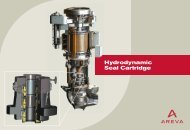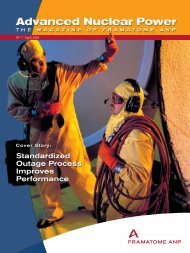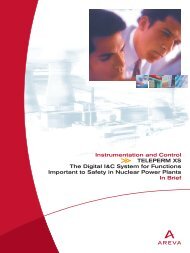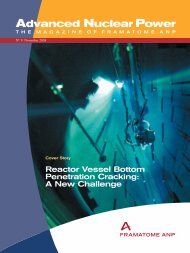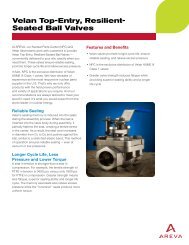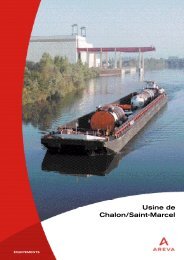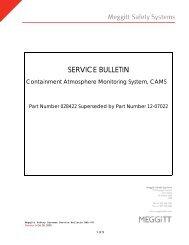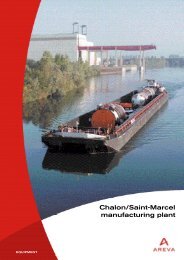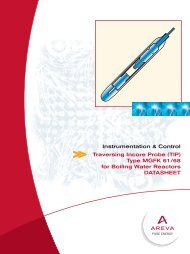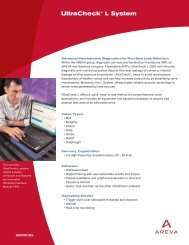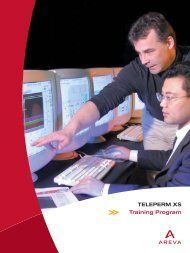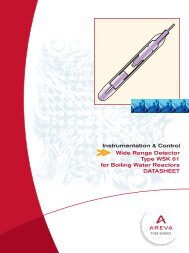EPR – Areva brochure
EPR – Areva brochure
EPR – Areva brochure
You also want an ePaper? Increase the reach of your titles
YUMPU automatically turns print PDFs into web optimized ePapers that Google loves.
■ <strong>EPR</strong> NUCLEAR ISLANDInstrumentation (level 0)A number of instrumentation channels supply measured data forcontrol, surveillance and protection systems and for information of thecontrol room staff. Multiple-channel acquisition is used for importantcontrols such as control of pressure and temperature of the primarycoolant, liquid level in the reactor pressure vessel. Multiple-channeland diversified data acquisition means are implemented.Concerning the protection of the reactor, a major aspect is thecapacity to predict and measure the nuclear power (or neutron flux)level and the three dimensional distribution of power in the core.The measurement of the power level is performed using ex-coreinstrumentation which also provides signals to monitor the corecriticality. Relying on temperature measurements in the cold and hotlegs of the four primary loops, a quadruple-redundant primary heatbalance is achieved and complemented by neutron flux measurementswith very short response time.Prediction and measurement of the three-dimensional powerdistribution relies on two types of in-core instrumentation:• “movable” reference instrumentation to validate the core designand to calibrate the other sensors utilized for core surveillance andprotection purposes,• “fixed” instrumentation to deliver online information to thesurveillance and protection systems which actuate appropriateactions and countermeasures in case of anomalies or exceedingof predefined limits.The movable reference instrumentation for power distributionassessment is an “aeroball” system. Stacks of vanadium-alloy balls,inserted from the top of the pressure vessel, are pneumaticallytransported into the reactor core (inside guide thimbles of fuelassemblies), then, after three minutes in the core, to a bench where theactivation of each probe is measured at 30 positions in five minutes.This gives values of the local neutron flux in the core, which areprocessed to construct the three-dimensional power distribution map.The fixed in-core instrumentation consists of neutron detectorsand thermocouples to measure the neutron flux radial and axialdistribution in the core and temperature radial distribution at the coreoutlet. The neutron flux signals are utilized to control the axial powerdistribution, and for core surveillance and protection. The core outletthermocouples continuously measure the fuel assembly outlettemperature and provide signals for core monitoring in case of lossof coolant event. They also provide information on radial powerdistribution and thermal-hydraulic local conditions.AAeroball systemCarrier gasBall guide tubeShroudSteel ballsBall stopActive core height<strong>EPR</strong> in-core instrumentationB C D E F G H J K L M N P R S TLimitation functions and protectionof the reactor (level 1)Four-channel limitation functions are implemented to rule outimpermissible operational conditions that would otherwise causereactor trip actions to be initiated. They also ensure that processvariables are kept within the range on which the safety analysis isbased, and they initiate actions to counteract disturbances that arenot so serious as to require the protection system to trip the reactor.The protection system counteracts accident conditions, first bytripping the reactor, then by initiating event-specific measures. Asfar as reasonably possible, two diverse initiation criteria are availablefor every postulated accident condition.Reactor trip is actuated by cutting off the power to the electromagneticgripping coils of the control rod drive mechanisms. All thecontrol assemblies drop into the core under their own weight andinstantaneously stop the chain reaction.† An enhanced and optimized degreeof automated plant control, associatedto an advanced Man-Machine interfacefor operator information and action.Man-Machine interface (level 2)At the design stage of the <strong>EPR</strong>, due consideration has been givento the human factor for enhancing the reliability of operators’ actions,during operation, testing and maintenance phases. This is achievedby applying appropriate ergonomic design principles and providingsufficiently long periods of time for the operators’ response toencountered situations or events.Sufficient and appropriate information is made available to theoperators for their clear understanding of the actual plant status,including in the case of a severe accident, and for a relevantassessment of the effects of their actions.The plant process is supervised and controlled from the Main ControlRoom which is equipped, regarding information and control, with:• two screen-based workstations for the operators,•a plant overview panel which gives information on the status andmain parameters of the plant,•a screen-based workstation for presenting information to the shiftsupervisor and the safety engineer,• an additional workstation for a third operator to monitor auxiliarysystems.The Remote Shutdown Station is provided with the same informationand data on the process as the Main Control Room.The plant also comprises a Technical Support Centre. It is a roomwith access to all the data concerning the process and its control,to be used, in case of accident, by the technical team in charge ofanalysing the plant conditions and supporting the post accidentmanagement.1716151413121110987654321241 Fuel assemblies89 Control rods12 In-core detectors40 Aeroball probes12 Instrumentationlance yokesA computerized screen-based control room designed to maximize operator efficiency. Chooz B1, France (N4, 1,500 MWe).42 II 43



